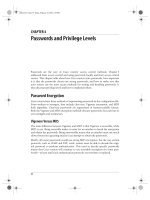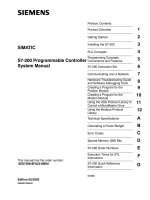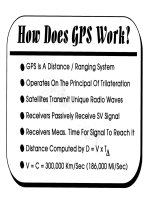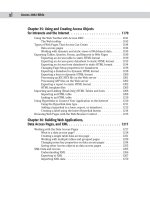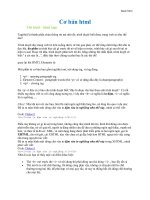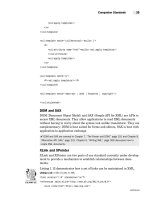Tài liệu Signals and Systems P2 pdf
Bạn đang xem bản rút gọn của tài liệu. Xem và tải ngay bản đầy đủ của tài liệu tại đây (253.69 KB, 20 trang )
SIGNALS
AND
SYSTEMS
[CHAP.
1
(a)
x(r
-
2)
is sketched in Fig.
1-18(a).
(6) x(20
is sketched in Fig.
1-18(b).
(c)
x(t/2)
is sketched in Fig.
1-18(c).
(d)
X(
-t)
is sketched in Fig.
1-1Nd).
(c)
Fig.
1-18
1.2.
A
discrete-time signal
x[n]
is shown in Fig.
1-19.
Sketch and label each of the
following signals.
(a)
x[n
-
21;
(b)
x[2n];
(c)
x[-n];
(d)
x[-n
+
21
Fig.
1-19
CHAP.
11
SIGNALS
AND
SYSTEMS
(a) x[n
-
21
is sketched in Fig.
1-20(a).
(b) x[2n]
is sketched in
Fig.
1-20(b).
(c)
x[-n]
is sketched in Fig.
1-2Nc).
(d) x[-n
+
21
is sketched in Fig.
1-2Nd).
(4
Fig.
1-20
13.
Given the continuous-time signal specified by
x(t)
=
(A
-
It'
-1lfll
otherwise
determine the resultant discrete-time sequence obtained by uniform sampling
of
x(t)
with a sampling interval of
(a)
0.25
s,
(b)
0.5
s,
and
(c)
1.0
s.
It
is easier to take the graphical approach for this problem. The signal
x(t)
is plotted in
Fig.
1-21(a).
Figures
1-21(b)
to
(dl
give plots of the resultant sampled sequences obtained for
the three specified sampling intervals.
(a)
T,
=
0.25
s. From Fig.
1-21(b)
we obtain
x[n]
=
(.
.
.
,0,0.25,0.5,0.75,1,0.75,0.5,0.25,0,.
.
.)
T
(b)
T,
=
0.5
s. From Fig.
1-21(c)
we obtain
x[n]=
{
,
0,0.5,1,0.5,0
, I
T
SIGNALS AND SYSTEMS
[CHAP.
1
(4
Fig.
1-21
(c)
T,
=
1
s.
From
Fig.
1-21(d)
we
obtain
x[n]
=
(.
.
.,O,
1,O
.
.)
=
S[nl
1.4.
Using the discrete-time signals
x,[n]
and
x,[n]
shown in Fig.
1-22,
represent each of
the following signals
by
a graph and
by
a sequence of numbers.
(a)
yJn1
=x,[nl +x,[nl;
(b)
y,[nI= 2x,[nl;
(c)
y,[nI =xJnIxJnl
Fig.
1-22
CHAP.
11
SIGNALS AND
SYSTEMS
(a)
y,[n]
is sketched in Fig.
1-23(a).
From Fig.
1-23(a)
we obtain
(b)
y2[n]
is sketched in Fig.
1-23(b).
From Fig.
1-23(b)
we obtain
(c)
yJn]
is sketched in
Fig.
1-23(c).
From Fig.
1-23(c)
we obtain
(d
Fig.
1-23
1.5.
Sketch and label the even and odd components of the signals shown in
Fig.
1-24.
Using Eqs.
(1.5)
and
(1.6),
the even and odd components of the signals shown in Fig.
1-24
are sketched in Fig.
1-25.
SIGNALS AND SYSTEMS
[CHAP.
1
(4
Fig.
1-24
1.6.
Find the even and odd components
of
x(r)
=
eJ'.
Let
x,(r)
and
x,(I)
be the even and odd components of
ei',
respectively.
eJ'
=x,(I)
+x,(I)
From
Eqs.
(1.5)
and
(1.6)
and using Euler's formula, we obtain
x,(
I)
=
$(eJr
+
e-J')
=
cos
I
x,,(I)
=
f(ei'-e-j')
=jsint
Show that the product of two even signals or of two odd signals is an even signal and
that the product of an even and an odd signaI is an odd signal.
Let
x(t) =xl(t)x2(t).
If
XJI)
and
x2(l)
are both even, then
x(-l) =x,(-I)X,(-t) =xI(I)x2(t) =x(t)
and
x(t)
is even.
If
x,(t)
and
x2(t)
are both odd, then
x(-I) =x,(-I)x,(-I)
=
-x,(t)[-x2(t)] =x1(t)x2(t) =x(t)
and
x(t)
is even. If
x,(t)
is even and
x2(f)
is odd, then
and
X(I)
is odd. Note that in the above proof, variable
I
represents either a continuous or a
discrete variable.
CHAP.
11
SIGNALS
AND
SYSTEMS
(4
Fig.
1-25
SIGNALS AND SYSTEMS
1.8.
Show
that
[CHAP.
1
(a)
If
x(t)
and
x[n]
are even, then
(b)
If
x(t)
and
x[n]
are odd, then
x(0)
=
0
and
x[O] =O
k
/a
~(r) dr
=
0
and
x
x[n] =O
-a
n=
-k
(a)
We can write
Letting
t
=
-A
in the first integral on the right-hand side, we get
Since
x(t)
is even, that is,
x( -A)
=
x(A),
we have
Hence,
Similarly,
Letting
n
=
-m
in the first term on the right-hand side, we get
Since
x[n]
is even, that is,
x[ -m] =x[m],
we have
Hence,
(1.75a)
(I.
75b)
(6)
Since
x(t)
and
x[n]
are odd, that is,
x(
-
t)
=
-x(t)
and
x[ -n]
=
-x[n],
we have
X( -0)
=
-x(O)
and
x[-01
=
-x[O]
CHAP.
11
SIGNALS
AND
SYSTEMS
Hence,
Similarly,
and
in view of Eq. (1.76).
1.9.
Show that the complex exponential signal
(
t
)
=
,j@d
is periodic and that its fundamental period is
27r/00.
By
Eq.
(1.7), x(t) will be periodic if
ei@dt
+
TI
=
eiwd
Since
eiw~(r
+
T)
=
eiqreiq,T
we must have
eimoT
=
1
(1.78)
If
w,
=
0,
then x(t)
=
1, which is periodic for any value of
T.
If
o0
#
0,
Eq.
(1.78) holds
if
27T
ooT=m2r or T=m-
m
=
positive integer
a0
Thus, the fundamental period To,
the
smallest positive T, of x(t) is given by 2r/oo.
1.10.
Show that the sinusoidal signal
x(t)
=
cos(w,t
+
8)
is periodic and that its fundamental period is
27r/wo.
The sinusoidal signal x(l) will be periodic if
cos[o,(t
+
T)
+
81
=
ws(oot
+
8)
We note that
cos[w,(t
+
T)
+
81
=
cos[oot
+
8
+
woT]
=
cos(oot
+
8)
SIGNALS AND SYSTEMS
[CHAP.
1
27
w0T=m2.rr or T=m- m
=
positive integer
*o
Thus. the fundamental period To of
x(r)
is given by 2.rr/wo.
1.11.
Show that the complex exponential sequence
x[n]
=
e~"~"
is periodic only
if
fl0/2.rr
is a rational number.
By Eq.
(1.9),
x[n] will be periodic if
,iflo(" +Nl
=
,in,,n,i~hp
=
,inon
or
ein~N
=
1
Equation
(1.79)
holds only if
floN =m2~
m
=
positive integer
or
a0
m
-=
-
=
rational number
2.rr N
Thus, x[n] is periodic only if R0/27r is a rational number
1.12.
Let
x(r)
be the complex exponential signal
with radian frequency
wo
and fundamental period
To
=
2.rr/oo.
Consider the
discrete-time sequence
x[n]
obtained by uniform sampling of
x(t)
with sampling
interval
Ts.
That is,
x[n] =x(nT,)
=eJ"unT.
Find the condition on the value of
T,
so that
x[n]
is periodic.
If x[n] is periodic with fundamental period
N,,,
then
,iou(n+N,,)T,
=
,iw~nT,,iwuN,J',
=
ejwun-l;
Thus, we must have
T,
m
-=
-
rational number
To
No
Thus
x[n]
is periodic if the ratio T,/T,, of the sampling interval and the fundamental period of
x(t)
is a rational number.
Note that the above condition is also true for sinusoidal signals x(t)
=
cos(o,,t
+
8).
CHAP.
11
SIGNALS
AND
SYSTEMS
1.13.
Consider the sinusoidal signal
x(t)
=
cos
15t
Find the value
of
sampling interval
T,
such that
x[n]
=
x(nT,)
is a periodic
sequence.
Find the fundamental period
of
x[n]
=
x(nT,)
if
TT
=
0.1~
seconds.
The fundamental period of
x(t)
is
To
=
2*rr/wo
=
27/15.
By Eq.
(1.81), x[n] =x(nTs)
is
periodic
if
where
m
and
No
are positive integers. Thus, the required value of
T,
is given by
Substituting
T,
=
0.1~
=
~/10
in Eq.
(1.821,
we have
Thus,
x[n] =x(nT,)
is periodic. By
Eq.
(1.82)
The smallest positive integer
No
is obtained with
m
=
3.
Thus, the fundamental period of
x[nl
=
x(0.l~n)
is
N,
=
4.
.4.
Let
x,(t)
and
x,(t)
be periodic signals with fundamental periods
T,
and
T2,
respec-
tively. Under what conditions is the sum
x(t) =x,(t)
+
x2(t)
periodic, and what is the
fundamental period of
x( t)
if it is periodic?
Since
x,(t)
and
x,(t)
are periodic with fundamental periods
TI
and
T,,
respectively, we
have
xl(t) =x,(t
+
TI)
=x,(t
+
mT,) m
=
positive integer
x2(t) =x2(t
+
T2) =x2(f
+
kT2) k
=
positive integer
Thus,
In order for
x(t)
to be periodic with period
T,
one needs
Thus, we must have
mT,
=
kT2
=
T
TI
k
=
rational number
T2 m
In other words, the sum of two periodic signals is periodic only
if
the ratio of their respective
periods can be expressed as a rational number. Then the fundamental period is the least
SIGNALS AND SYSTEMS
[CHAP.
1
common multiple of T, and T2, and it is given by Eq. (1.84) if the integers m and k are relative
prime. If the ratio T,/T, is an irrational number, then the signals x,(t) and x,(t) do not have a
common period and x(t) cannot be periodic.
1.15.
Let x,[n] and x2[n] be periodic sequences with fundamental periods
N,
and N2,
respectively. Under what conditions is the sum x[n] =x,[n] +x2[n] periodic, and what
is the fundamental period of x[n] if
it
is periodic?
Since x,[n] and x2[n] are periodic with fundamental periods N, and N2, respectively, we
have
xI[n] =xI[n
+
N,] =x,[n +mN,]
m
=
positive integer
x2[n] =x,[n
+
N,] =x,[n
+
kN,]
k
=
positive integer
Thus,
~[n] =x,[n +mN,] +x2[n
+
kN,]
In order for x[n] to be periodic with period N, one needs
x[n
+
N] =x,[n
+
N]
+x2[n
+
N] =x,[n
+
mN,] +x,[n
+
kN2]
Thus, we must have
mN,
=
kN2
=
N
Since we can always find integers m and k to satisfy
Eq.
(1.861, it follows that the sum of two
periodic sequences is also periodic and its fundamental period is the least common multiple of
N, and N,.
1.16.
Determine whether or not each of the following signals is periodic.
If
a signal is
periodic, determine its fundamental period.
2TT
(a)
x(t)
=
cos
(b)
x(t)=sinpt
3
T
TT
(c)
x(t)=cos-I +sin -t
3
4
(dl
x(t)=cost+sinfit
(el
x(t)
=
sin2
t
(f)
X(t)
=
eiI(r/2)f-
11
(g)
x[n]
=
ej("/4)"
(h)
x[n]=cosfn
T
T
TT
(i)
x[n]
=
cos -n
+
sin -n
3
4
(j)
x[n]
=
cos2 -n
8
x(t) is periodic with fundamental period T,
=
27r/w0
=
27r.
x(r) is periodic with fundamental period TO
=
27r/o,,
=
3.
lr lr
(c)
x(t)
=
cos
I
+
sin -t =x,(t) +x2(t)
3 4
where x,(t)
=
cos(7r/3)r
=
cos w,t is periodic with T,
=
27r/w,
=
6
and x2(t)
=
sin(~/4)t
=
sin w2t is periodic with T2
=
21r/w2
=
8.
Since T,/T,
=
=
is a rational
number, x(t) is periodic with fundamental period To
=
4T,
=
3T2
=
24.
CHAP.
11 SIGNALS AND SYSTEMS
(dl
x(t)
=
cos
r
+
sin
fir
=x,(r) +x2(r)
where x,(t)
=
cos
r
=
cos o,t is periodic with TI
=
27r/01
=
27r and x2(t)
=
sin fit
=
sin w2t is periodic with T2
=
27r/02
=
fir.
Since T,/T2
=
fi
is an irrational number,
x(t) is nonperiodic.
(e) Using the trigonometric identity sin2
0
=
t(l
-
cos 201, we can write
I
where x,(t)
=
$
is a dc signal with an arbitrary period and x2(t)
=
-
$
cos2r
=
-
cos 02t
is periodic with T2
=
2n/w2
=
7.
Thus, x(t) is periodic with fundamental period To
=
T.
7T
(f)
x(t)
=
ejt(r/2)r-
11
=
e-jej(r/2)r
=
-I
'e
jwd
,
Wo
=
Ir
L
x(t) is periodic with fundamental period To
=
27r/w0
=
4.
Since R0/27r
=
$
is a rational number, x[nl is periodic, and by
Eq.
(1.55) the fundamen-
tal period is No
=
8.
x[n]
=
cos fn
=
cos non
,
Ro
=
$
Since n0/27r
=
1/8~ is not a rational number, x[n] is nonperiodic.
7r
T
x[n]
=
cos -n
+
sin
-n
=
x,[n]
+
x2[n
1
3
4
where
7r
7r
x2[n]
=
sin -n
=
cos
f12n
+
0,
=
-
4
4
Since R,/2~r
=
(=
rational number), xl[n] is periodic with fundamental period N,
=
6,
and since R2/27r
=
$
(=
rational number), x2[n] is periodic with fundamental period
N2
=
8. Thus, from the result of Prob. 1.15, x[n] is periodic and its fundamental period is
given by the least common multiple of
6
and
8,
that is, No
=
24.
Using the trigonometric identity cos2 8
=
i(l
+
cos28), we can write
T117r
x[n]
=
cost -n
=
-
+
-
cos
-n
=x,[n] +x2[n]
8
22 4
where x,[n]
=
$
=
$(l)" is periodic with fundamental period
Nl
=
1 and x2[n]
=
1
cos(a/4)n
=
cos R2n
,
Q2
=
~/4. Since R2/27r
=
(
=
rational number), x2[n] is
periodic with fundamental period N2
=
8. Thus, x[n] is periodic with fundamental period
No
=
8
(the least common multiple of N, and N,).
1.17.
Show that
if
x(t
+
T)
=
x(t),
then
for any real
a,
p,
and
a.
SIGNALS AND SYSTEMS
[CHAP.
1
If
x(t
+
T) =x(t),
then letting
t
=
7
-
T,
we have
X(T-T+T)=x(r) =x(T-T)
and
Next, the right-hand side of
Eq.
(1.88)
can be written as
By
Eq.
(1.87)
we have
(t) d
=
/
x(t) dt
a+T
Thus.
1.18.
Show that
if
x(t)
is periodic with fundamental period
To,
then the normalized average
power
P
of
x(t)
defined by Eq.
(1.15)
is the same as the average power of
x(0
over
any interval
of
length
T,,
that is,
By
Eq.
(
1.15)
1
P
=
lim
-
/T'2
1
x(t)
1'
dt
T r:
T
-7./2
Allowing the limit to be taken
in a manner such that
T
is an integral multiple of the
fundamental period,
T
=
kT,,
the total normalized energy content of
x(t)
over an interval of
length
T
is
k
times the normalized energy content over one period. Then
1.19.
The following equalities are used on many occasions in this text. Prove their validity.
Then
SIGNALS
AND
SYSTEMS
N-
1
aS=a
C
an=a+aZ+a"
+
+aN
n=O
Subtracting
Eq.
(1.95) from
Eq.
(1.941, we obtain
Hence if
a
#
1,
we have
If
a
=
1,
then
by
Eq.
(1.94)
(6)
For
la1
<
1,
lim
aN
=
0. Then
by
Eq.
(1.96) we obtain
N-m
m
N-
l
]-aN
I
x
an
=
lim
x
an
=
lim
-
-
n-0
N-m
n
=O
N
I-
1-a
(c)
Using
Eq.
(1.911, we obtain
(d) Taking the derivative of both sides of
Eq.
(1.91) with respect to
a,
we have
and
Hence,
1.20.
Determine whether the following signals are energy signals, power signals, or neither.
(a) x(t)=e-"'u(t), a>O
(b)
x(t)=Acos(w,t+8)
(c)
x(t)
=
tu(t)
(dl
x[n]
=
(-
0.5)"u[n]
(e)
x[nl= u[nl
(f
x[n]
=
2ej3"
SIGNALS
AND
SYSTEMS
[CHAP.
1
Thus,
x(t)
is an energy signal.
(b)
The sinusoidal signal
x(t)
is periodic with
To
=
27r/oo.
Then
by
the result from
Prob. 1.18, the average power of
x(t
)
is
Thus,
x(t)
is a power signal. Note that periodic signals are, in general, power signals.
Thus,
x(t)
is neither an energy signal nor a power signal.
(d)
By
definition
(1.16)
and using
Eq.
(1.91),
we obtain
Thus,
x[nl
is an energy signal.
(e)
By
definition
(1.17)
1
N
P=
lim
C
lxb1I2
N+%
2N+
1
,=-N
1
1
=
lim
-
1
=
lim
(N+l)=-<a
N+C=
2N+
1
,,=,,
~+m
2N+
1
2
Thus,
x[n]
is a power signal.
(f
Since
Ix[n]l= I2eiJnI
=
2IeJ3"l
=
2,
1
N
1
P
=
lim
C
lx[n]12=
lim
-
N-+=
2N
+
l
n=
-N
2'
N-m
2N
+
1
.=
-N
1
=
lim
-
4(2N+
1)
=4<m
~+m
2N+
1
Thus,
x[n]
is a power signal.
BASIC SIGNALS
1.21.
Show
that
CHAP.
11
SIGNALS AND SYSTEMS
Let
T
=
-
t.
Then by definition
(1.18)
Since
T
>
0 and
7
<
0
imply, respectively, that
t
<
0 and
r
>
0, we obtain
which is shown in Fig.
1-26.
Fig.
1-26
1.22.
A
continuous-time signal
At)
is shown in Fig.
1-27.
Sketch
and
label each of the
following signals.
(a)
x(t)u(l
-
t);
(b)
x(t)[u(t)
-
u(t
-
I)];
(c)
x(t)Ht
-
-1012
t
Fig.
1-27
(a)
By definition
(1.19)
and
x(r)u(l
-
t)
is sketched in
Fig.
1-28(a).
(6)
By definitions
(1.18)
and
(1.19)
O<tll
u
-
(t
-
1
=
otherwise
and
x(t)[u(r)
-
u(t
-
I)]
is sketched in Fig.
1-28(b).
SIGNALS AND SYSTEMS
(c)
By
Eq.
(1.26)
x(t)s(t
-
3)
=x($)s(t
-
$)
=
26(t
-
$)
which is sketched in Fig.
1-28(c).
[CHAP.
1
(c)
Fig.
1-28
1.23.
A
discrete-time signal
x[n]
is shown in Fig.
1-29.
Sketch and label each
of
the
following signals.
(a)
x[n]u[l
-
n];
(b)
x[n](u[n
+
21
-
u[n]};
(c)
x[n]6[n
-
11
-4-3-2-1
0
12
3
4
5
n
Fig.
1-29
(a)
By
definition
(1.44)
and
x[n]u[l
-
n]
is sketched in
Fig.
1-30(a).
CHAP.
11
SIGNALS
AND
SYSTEMS
(b)
By
definitions
(1.43)
and
(1.44)
-21n
<0
u[n
+
21
-
u[n]
=
otherwise
and
x[n](u[n
+
21
-
u[n])
is sketched in
Fig.
1-30(b).
(c)
By
definition
(1.48)
n=l
x[n ]S[n
-
11
=x[l]S[n
-
I]
=
S[n
-
11
=
which is sketched in
Fig.
1-30(c).
(4
Fig.
1-30
1-24
The unit step function
u(t)
can be defined as a generalized function by the following
relation:
m
1-
m
+(t)u(t) dt
=
jw4(t) dt
(1.98)
0
where
&(t)
is
a
testing function which is integrable over
0
<
t
<
m.
Using this
definition, show that
Rewriting
Eq.
(1.98)
as
38
SIGNALS
AND
SYSTEMS
[CHAP.
1
we obtain
This can be true only if
0
1-
a
4(t)u(t) dt
=
0
and
kw4(t)[l
-
u(t)] dt
=
0
These conditions imply that
b(t)u(t)
=
0, t
<
0
and
c$(t)[l
-
u(t)]
=
0,
t
>
0
Since
4(t)
is arbitrary, we have
u(t)=O, t<O
and
1
-u(t)=O,t>O
that is,
1.25.
Verify
Eqs.
(1.23)
and
(1.24),
that
is,
1
(a) 6(at)
=
-6(t);
(b)
S(-t)
=
S(t)
la1
The proof will be based on the following
equiualence
property:
Let
g,(t)
and
g2(t)
be generalized functions. Then the equivalence property states that
g,(t) =gt(t)
if
and only if
for all suitably defined testing functions
4(t).
(a)
With a change of variable,
at
=
T,
and hence
t
=
r/a, dt
=
(l/a) dr,
we obtain the
following equations:
If
a
>
0,
Thus, for any
a
CHAP.
11
SIGNALS AND SYSTEMS
Now, using Eq.
(1.20)
for
4(0),
we obtain
for any
4(t).
Then, by the equivalence property
(1.991,
we obtain
1
6(at)
=
-6(t)
la1
(6)
Setting
a
=
-
1
in the above equation, we obtain
1
6( -t)
=
-6(t)
=
S(t)
I-
11
which shows that
S(t)
is
an
even function.
1.26.
(a)
Verify
Eq.
(1.26):
x(t)8(t
-
to) =x(t,)S(l
-
1,)
if
x(t)
is continuous at
t
=
to.
(b)
Verify
Eq.
(1.25):
x(r)S(t) =x(O)S(t)
if
x(t)
is continuous at
t
=
0.
(a)
If
x(t)
is continuous at
t =to,
then by definition
(1.22)
we have
for all
+(t)
which are continuous at
t
=
to.
Hence, by the equivalence property
(1.99)
we
conclude that
x(t)6(t
-
to) =x(to)6(t
-
t,,)
(6)
Setting
to
=
0
in the above expression, we obtain
x(t)b(t) =x(O)S(t)
1.27.
Show that
(a)
t8(t)
=
0
(b)
sin
t8(r)
=
0
(c)
COS
tS(t
-
r)
=
-S(t
-
T)
